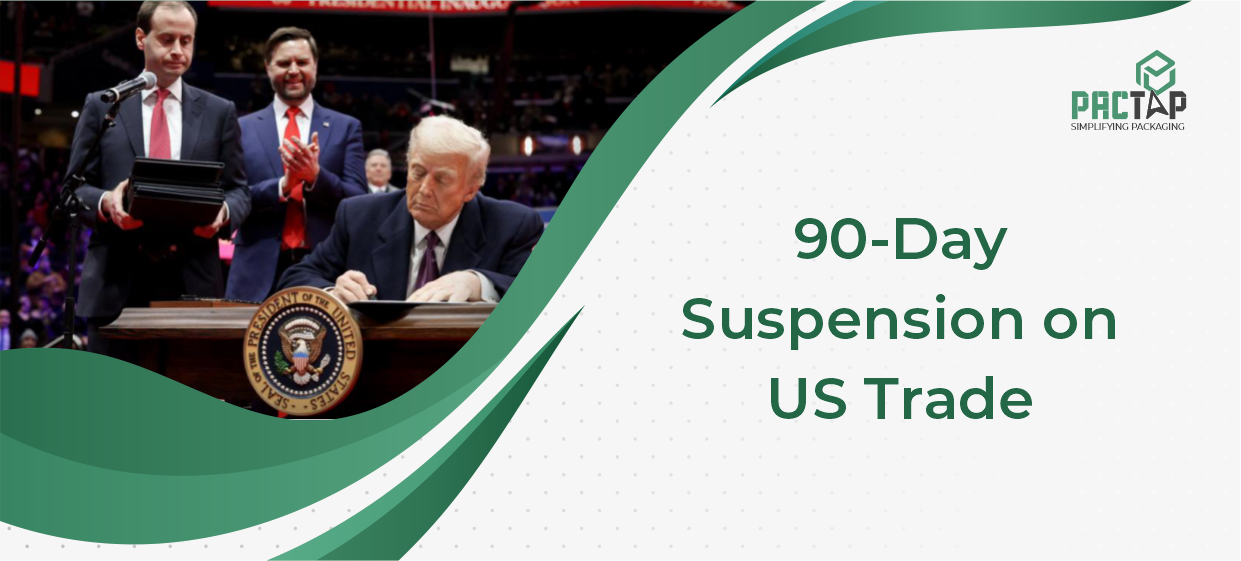April 9, 2025, marked a significant turning point in the United States’ trade policy, characterized by a two-pronged approach towards its global trading partners. On one hand, the US dramatically escalated trade tensions with China by imposing a massive 125% tariff on all Chinese imports. On the other hand, it announced a 90-day suspension on implementing similar tariff increases for other countries, maintaining a baseline tariff of 10% during this period. This dual announcement has sent shockwaves through the international economic landscape, raising numerous questions about the motivations behind these decisions and their potential ramifications. Let’s delve into the complexities of these simultaneous actions and explore their interconnected implications for global trade.
NOTE: In a move that further intensifies trade relations, the United States has increased tariffs on imports from China to 125%, potentially reaching 145% on some goods, effective April 10, 2025. This was met with a swift response from China, which imposed a retaliatory tariff of 125% on all goods originating from the USA, starting April 11, 2025.
What Exactly Are Tariffs, and Why Are They Being Used So Differently for China and Other Nations?
Tariffs, at their core, are taxes levied by a government on imported goods. They serve various purposes, including protecting domestic industries, generating revenue, and acting as a tool in international trade negotiations. In the context of the US’s recent actions, the stark difference in tariff treatment between China and other countries suggests distinct motivations and strategic considerations for each group. The drastic 125% tariff on China signals a strong stance against perceived unfair trade practices, while the suspension for others could indicate a desire to maintain stability or pursue different negotiation strategies with those partners.
When Did the US Implement the 125% Tariff on Chinese Imports, and What Does This Drastic Increase Mean?
The 125% tariff on all goods imported from China came into effect on April 9, 2025. This represents a monumental increase from previous tariff levels, which had already seen several rounds of hikes in recent years. A tariff of this magnitude essentially makes Chinese goods significantly more expensive for American businesses and consumers, potentially leading to a substantial decrease in demand for these products in the US market.
What Were the Previous Tariff Rates on Chinese Goods Before This Sharp Increase?
Before April 9, 2025, the average tariff rate on Chinese imports into the United States was considerably lower than 125%. While specific rates varied across different product categories, the overall level was a result of previous trade disputes and negotiations. This new 125% tariff represents a decisive escalation, indicating a significant shift in the US’s approach to its trade relationship with China.
What Are the Officially Stated Reasons Behind the US Imposing Such High Tariffs on China?
The US government has consistently cited several reasons for its trade actions against China. These typically include allegations of intellectual property theft, forced technology transfer, state subsidies that disadvantage foreign competitors, and the persistent trade imbalance between the two nations. The drastic tariff increase likely aims to exert maximum pressure on China to address these concerns and alter its trade practices.
How Is This Massive Tariff Hike Expected to Impact the Chinese Economy?
A 125% tariff is expected to have a significant negative impact on the Chinese economy, particularly its massive export sector. The United States is a major market for Chinese goods, and such a high tariff could drastically reduce the competitiveness of these products. This could lead to decreased production, job losses in export-oriented industries, and a slowdown in China’s overall economic growth.
What Challenges Will American Businesses Face as a Result of These Higher Tariffs on Chinese Goods?
While the tariffs are intended to protect American industries, they will also present significant challenges for US businesses. Many companies rely on importing components or finished goods from China due to cost efficiencies and established supply chains. The 125% tariff will substantially increase their costs, potentially forcing them to raise prices for consumers, absorb lower profit margins, or seek alternative (and potentially less efficient or more expensive) suppliers outside of China.
How Will US Consumers Likely Be Affected by the Increased Cost of Goods Imported from China?
Ultimately, a significant portion of the increased costs associated with the 125% tariff on Chinese imports is likely to be passed on to American consumers. A wide range of everyday goods, including electronics, clothing, toys, and household items, that are heavily sourced from China will likely become more expensive. This could lead to a decrease in consumers’ purchasing power and potentially contribute to a higher cost of living.
Is This Tariff Hike Expected to Contribute to Inflationary Pressures Within the United States?
Economists widely anticipate that this substantial tariff increase will indeed contribute to inflationary pressures within the United States. As the cost of imported goods from China rises dramatically, retailers will likely need to increase their prices to maintain profitability. This could lead to a broad-based increase in the price level across various sectors of the economy, potentially eroding the real wages of American workers.
What Retaliatory Measures Might China Take in Response to These Unprecedented Tariffs?
China is highly likely to retaliate against this significant tariff increase by the United States. Potential responses could include imposing its own tariffs on goods imported from the US, implementing non-tariff barriers to trade, such as increased regulatory scrutiny or customs delays, or even pursuing legal action via the World Trade Organization (WTO). The scale and nature of China’s retaliation will significantly shape the future of the trade relationship between the two countries.
Could This Escalation Lead to a Further Broadening of the Trade Conflict Between the US and China?
The imposition of a 125% tariff significantly increases the risk of a further escalation of the trade conflict between the US and China. If China retaliates strongly, the US could respond with even higher tariffs or other trade restrictions, potentially leading to a damaging cycle of tit-for-tat measures that harms both economies and disrupts global trade.
Turning to Other Nations: What Exactly Does the US’s 90-Day Tariff Suspension Entail?
In contrast to the aggressive stance taken against China, the US has announced a 90-day suspension on implementing similar tariff increases for other countries. This means that for a period of 90 days, starting from April 9, 2025, the US will maintain a baseline tariff of 10% on imports from these nations, refraining from imposing any new or higher tariffs during this timeframe.
Which Specific Countries Are Included in This Temporary Suspension of Tariff Increases?
The announcement broadly refers to “other countries,” implying that this suspension applies to the majority of nations that trade with the United States, excluding China. This would likely encompass major trading partners in Europe, Asia (excluding China), North and South America, and Africa. The specific list could be subject to official clarification, but the intent seems to be a broad pause for most of the US’s trading partners.
What Is the Significance of Maintaining a 10% Baseline Tariff During This 90-Day Suspension?
While the suspension prevents further increases, it’s important to note that a 10% baseline tariff will still be in effect for these other countries. This indicates that the US is not entirely removing tariffs but rather pausing any planned escalations. This baseline level could still have an impact on the cost of imported goods, but it is significantly lower than the 125% now applied to China.
What Could Be the Underlying Motivations Behind the US Offering This 90-Day Suspension to Other Trading Partners?
There could be several strategic reasons behind this temporary suspension. It might be a move to avoid simultaneous trade disputes with a large number of countries, allowing the US to focus its attention and leverage on its relationship with China. It could also be a gesture to foster goodwill and potentially create an opportunity for dialogue and negotiation with these other nations on trade-related issues during this period. Furthermore, it might be intended to prevent widespread disruption to global supply chains beyond the already significant impact of the China tariffs.
How Does This Suspension for Other Nations Contrast with the Drastic Tariff Increase Imposed on China?
The contrast between the 125% tariff on China and the 90-day suspension at a 10% baseline for other countries is stark. It clearly signals a differentiated approach in the US’s trade policy, with China being singled out for significantly more aggressive measures. This difference highlights the specific concerns and objectives the US has regarding its trade relationship with China compared to its other trading partners.
What Potential Benefits Does This 90-Day Suspension Offer to the Affected Countries?
The 90-day suspension offers several potential benefits to the countries included. It provides a period of stability and predictability in their trade relationship with the US, allowing businesses to plan and invest with less uncertainty about potential tariff hikes. It also creates an opportunity for these countries to engage in discussions with the US government to address any existing trade concerns and potentially work towards more stable long-term trade arrangements.
Will This Period of Suspension Provide a Meaningful Opportunity for Trade Negotiations Between the US and These Other Nations?
Yes, the 90-day suspension period presents a valuable window for the US and the affected countries to engage in meaningful trade negotiations. This could involve discussions about existing trade agreements, potential areas for cooperation, and ways to address any trade imbalances or specific concerns. The suspension could be a confidence-building measure to facilitate these discussions.
What Are the Possible Scenarios That Could Unfold After the 90-Day Suspension Period Concludes?
The future after the 90-day suspension period is uncertain. Several scenarios are possible. The US could decide to maintain the 10% baseline tariff, potentially leading to further negotiations for more comprehensive trade agreements. Alternatively, depending on the progress of discussions or shifts in US trade policy objectives, the US could still decide to impose higher tariffs on some or all of these countries after the suspension ends.
How Might This Suspension Influence Global Supply Chains and Businesses Operating Outside of China?
The 90-day suspension could provide a degree of stability for global supply chains that involve countries other than China. Businesses that source goods or components from these nations can continue their operations with the existing tariff structure for the time being. This could lead some businesses to consider shifting their supply chains away from China towards these countries, given the significantly lower tariff environment.
Connecting the Dots: Understanding the Broader Implications of This Dual Trade Announcement
The simultaneous imposition of a 125% tariff on Chinese imports and the 90-day tariff suspension for other nations signifies a multi-faceted US trade strategy. It clearly escalates tensions with China, indicating a strong stance against its trade practices and potentially impacting global economic growth. Simultaneously, the temporary reprieve for other countries suggests a more targeted approach, possibly aimed at isolating China or leveraging relationships with other trading partners. This dual policy underscores the US’s continued reliance on tariffs as a trade tool, contributing to uncertainty in international trade and potentially reshaping global supply chains as businesses adapt to this differentiated approach in US trade policy.
How Do These Two Seemingly Contrasting Policies Fit Together Within the United States’ Overall Trade Strategy?
These seemingly contrasting policies might be part of a broader US trade strategy aimed at isolating China economically while maintaining relatively stable trade relations with other partners. The aggressive tariffs on China could be intended to pressure Beijing to make significant concessions on trade practices, while the suspension for others could be a way to build alliances and avoid alienating key trading partners during this period of heightened tension with China.
Could the 90-Day Suspension for Other Countries Be a Strategic Tactic Directly Related to the Tariffs Imposed on China?
Yes, the suspension could be a strategic tactic related to the China tariffs. By maintaining stable trade with other nations, the US might be aiming to reduce the potential for a united front against its trade policies and instead focus international pressure on China. It could also be a way to encourage businesses to diversify their supply chains away from China towards these other countries.
What Are the Broader Geopolitical Ramifications of These Simultaneous Trade Moves by the US?
These trade decisions have significant geopolitical ramifications. The increased tensions with China could further strain the already complex relationship between the two global powers, potentially impacting cooperation on other critical issues. The suspension for other countries could be seen as an attempt to strengthen relationships with allies and partners, potentially realigning global trade dynamics.
How Might Global Businesses Need to Adapt to This Differentiated Approach in US Trade Policy?
Global businesses will need to carefully analyze this differentiated approach in US trade policy and adapt their strategies accordingly. Companies heavily reliant on imports from China will need to explore options such as diversifying their sourcing, reshoring production, or adjusting their pricing strategies. Businesses operating in other countries will need to monitor the situation closely, prepare for potential changes after the 90-day suspension, and potentially explore opportunities arising from the shift in US-China trade.
What Does This Dual Announcement Signal About the Future Landscape of International Trade Relations?
This dual announcement signals a continued period of uncertainty and potential disruption in international trade relations. It suggests a willingness by the US to use tariffs aggressively to pursue its trade objectives, particularly with China. The temporary suspension for others indicates a more nuanced approach but also highlights the potential for future shifts in trade policies. The global trading system may continue to evolve as countries react to these developments and seek to protect their own economic interests.
Conclusion
The United States’ simultaneous announcement of a massive tariff hike on Chinese imports and a 90-day suspension for other countries paints a complex picture of its evolving trade policy. The aggressive stance towards China underscores the ongoing tensions and the US’s determination to address its trade concerns. Meanwhile, the temporary reprieve for other nations suggests a more cautious and potentially diplomatic approach. These dual actions will undoubtedly have significant repercussions for global trade, impacting businesses, consumers, and international relations. The coming months will be crucial in observing how these policies unfold and how the affected nations respond to this significant shift in the landscape of international trade.





